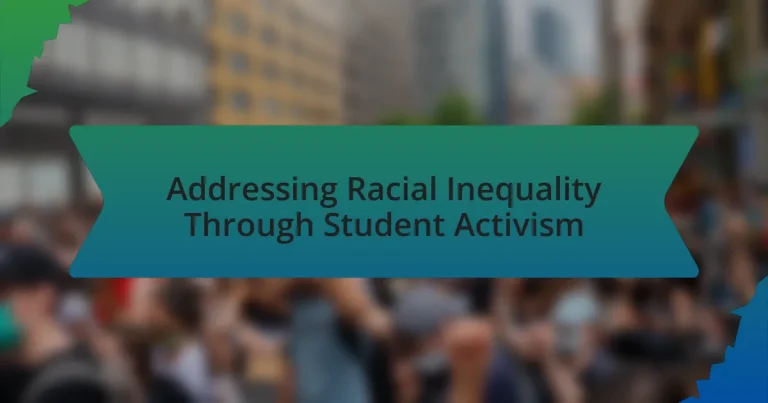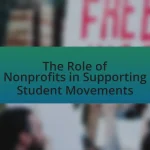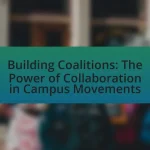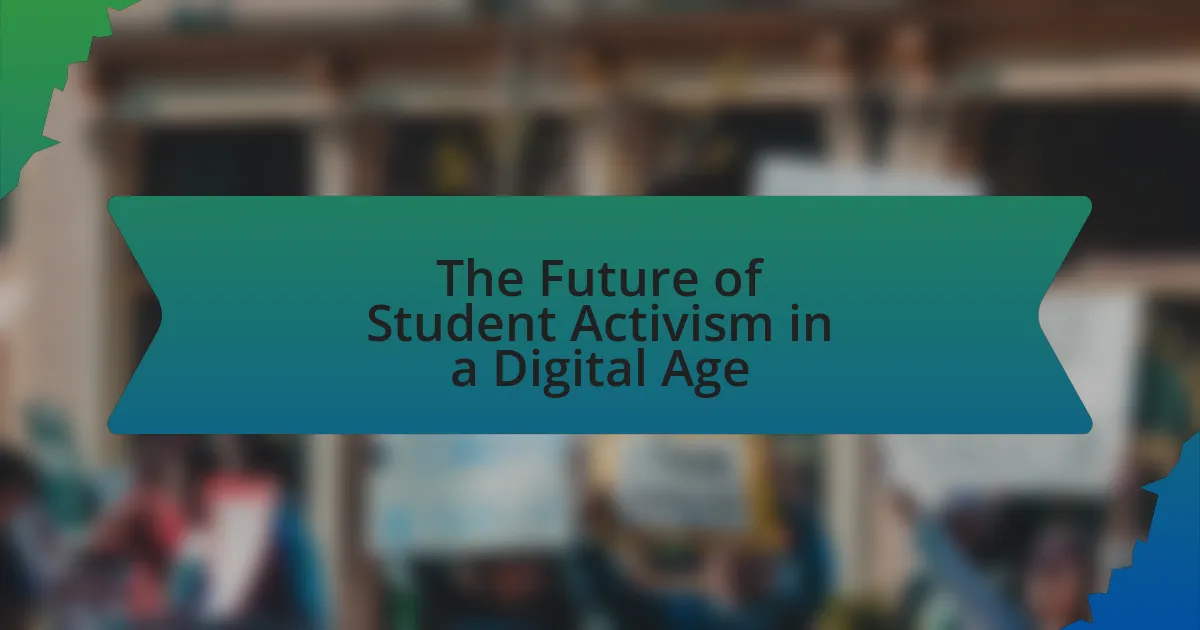Addressing racial inequality through student activism involves students actively engaging in efforts to combat systemic racism and promote social justice within their educational institutions and communities. The article explores the historical and contemporary significance of student-led movements, such as the Civil Rights Movement and Black Lives Matter, highlighting their role in raising awareness, influencing policy changes, and fostering dialogue around racial issues. It also examines the strategies employed by student activists, the challenges they face, and the long-term effects of their initiatives on promoting racial equality. Additionally, the article discusses the importance of collaboration with community organizations and the role of education in sustaining activism efforts.
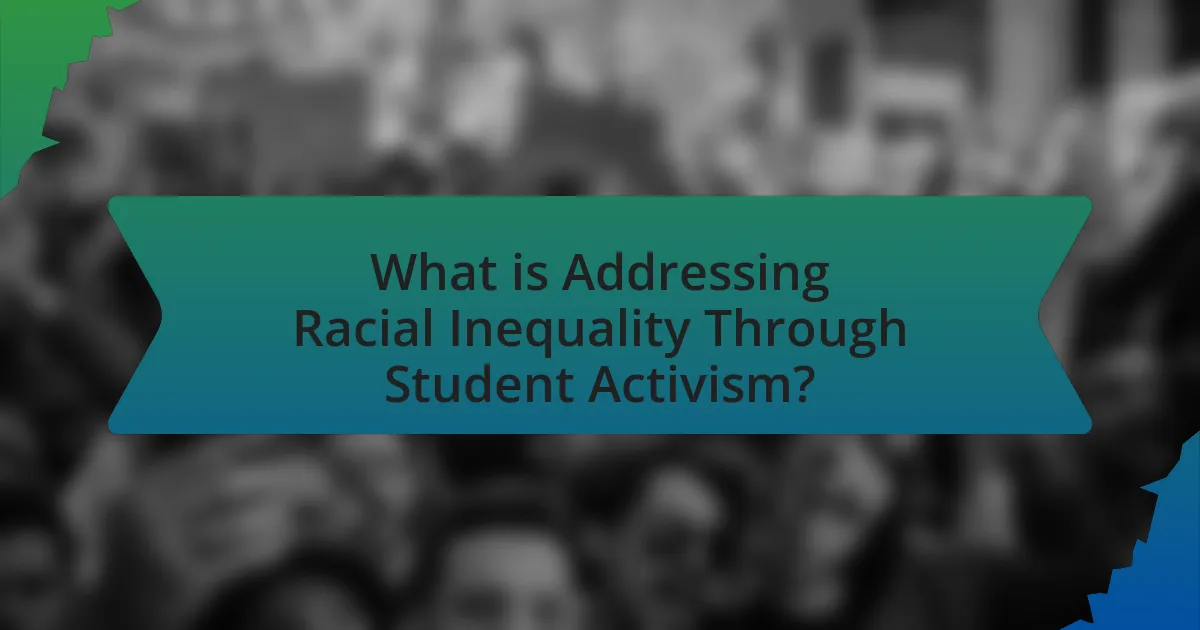
What is Addressing Racial Inequality Through Student Activism?
Addressing racial inequality through student activism involves students actively engaging in efforts to combat systemic racism and promote social justice within their educational institutions and communities. This activism often manifests through organized protests, awareness campaigns, and policy advocacy aimed at highlighting and dismantling discriminatory practices. For instance, the Black Lives Matter movement has seen significant participation from students who mobilize to demand equitable treatment and representation in schools. Research indicates that student-led initiatives can lead to tangible changes, such as the implementation of diversity training programs and the establishment of inclusive curricula, thereby validating the effectiveness of student activism in addressing racial inequality.
How does student activism contribute to addressing racial inequality?
Student activism contributes to addressing racial inequality by mobilizing young people to advocate for policy changes, raise awareness, and challenge systemic injustices. Through organized protests, campaigns, and educational initiatives, students have historically played a crucial role in movements such as the Civil Rights Movement, where student-led organizations like the Student Nonviolent Coordinating Committee (SNCC) were instrumental in pushing for desegregation and voting rights. Additionally, contemporary student activism, exemplified by movements like Black Lives Matter on campuses, highlights issues of police violence and institutional racism, fostering dialogue and demanding accountability from educational institutions. This activism not only influences public opinion but also pressures lawmakers to enact reforms aimed at reducing racial disparities, thereby contributing to a broader societal shift towards equality.
What historical examples illustrate the impact of student activism on racial issues?
Student activism has significantly impacted racial issues throughout history, with notable examples including the Civil Rights Movement in the 1960s and the anti-apartheid movement in South Africa. During the Civil Rights Movement, students from organizations like the Student Nonviolent Coordinating Committee (SNCC) organized sit-ins, protests, and voter registration drives, which were pivotal in challenging segregation laws and promoting racial equality. For instance, the Greensboro sit-ins in 1960 led to the desegregation of lunch counters in the South, demonstrating the effectiveness of student-led initiatives. Similarly, in South Africa, student protests in the 1970s, particularly the Soweto Uprising in 1976, highlighted the injustices of apartheid and mobilized international support against racial oppression, ultimately contributing to the end of apartheid in the 1990s. These examples illustrate how student activism has been a catalyst for change in addressing racial inequality.
How do student-led movements raise awareness about racial inequality?
Student-led movements raise awareness about racial inequality by mobilizing peers, organizing events, and utilizing social media to disseminate information. These movements often highlight systemic injustices through protests, educational campaigns, and community engagement, effectively reaching a broader audience. For instance, the Black Lives Matter movement, which gained significant traction among students, utilized social media platforms to share personal stories and statistics about racial violence, thereby increasing public consciousness and sparking discussions on campuses nationwide. Additionally, research indicates that student activism can lead to policy changes within educational institutions, further amplifying the message of racial equality and justice.
Why is student activism important in the fight against racial inequality?
Student activism is crucial in the fight against racial inequality because it mobilizes young people to advocate for social justice and challenge systemic discrimination. Historically, student-led movements, such as the Civil Rights Movement in the 1960s, have played a pivotal role in raising awareness and pushing for legislative changes, exemplified by the involvement of students in protests that led to the Civil Rights Act of 1964. Furthermore, contemporary student activism, as seen in movements like Black Lives Matter, utilizes social media to amplify voices and organize protests, effectively engaging a broader audience and fostering solidarity across diverse communities. This activism not only influences public opinion but also pressures institutions and policymakers to address racial disparities, making it a vital component in the ongoing struggle for equality.
What unique perspectives do students bring to the conversation on racial inequality?
Students bring fresh, diverse viewpoints to the conversation on racial inequality, shaped by their unique experiences and backgrounds. Their perspectives often highlight the intersectionality of race with other social issues, such as class, gender, and sexuality, which can deepen the understanding of systemic inequalities. For instance, research from the American Council on Education indicates that students of color are more likely to engage in discussions about racial justice and advocate for policy changes on campuses, reflecting their lived experiences with discrimination. This engagement not only enriches the dialogue but also fosters a sense of community and solidarity among diverse student groups, driving collective action toward racial equity.
How does student activism influence policy changes regarding racial issues?
Student activism significantly influences policy changes regarding racial issues by mobilizing public opinion and pressuring institutions to adopt reforms. For instance, movements such as Black Lives Matter, which gained momentum through student-led protests, have prompted legislative discussions on police reform and racial justice at local and national levels. Research indicates that student-led initiatives can lead to tangible policy outcomes; for example, the 2018 March for Our Lives, primarily organized by students, resulted in over 50 gun control laws being enacted across various states. This demonstrates that organized student activism not only raises awareness but also catalyzes legislative action aimed at addressing systemic racial inequalities.
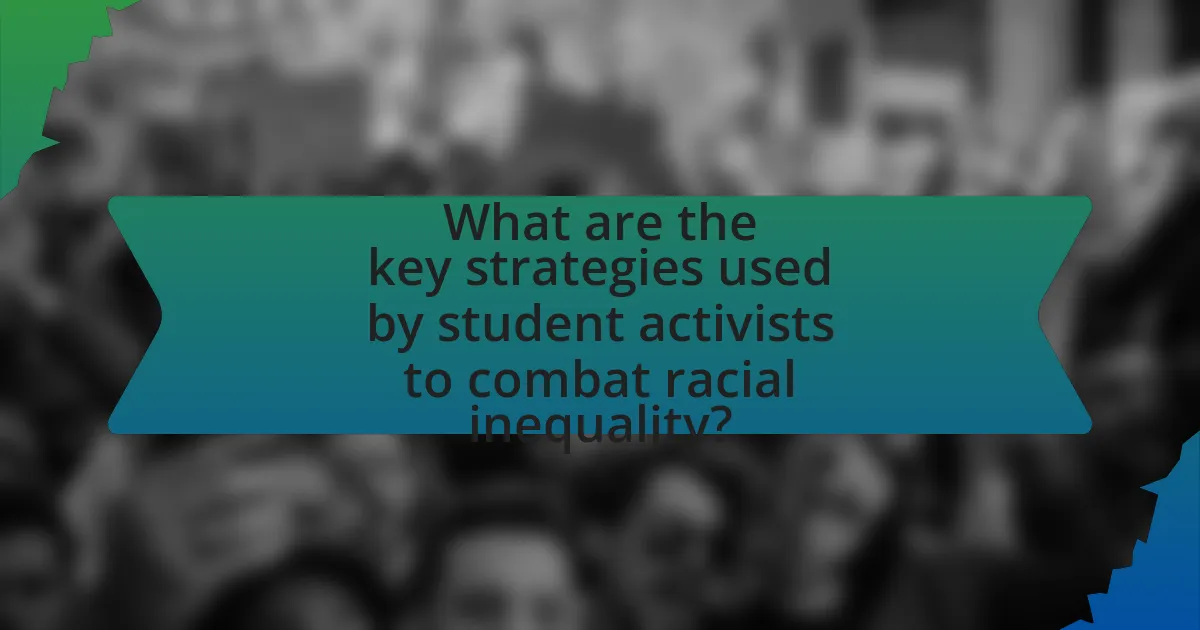
What are the key strategies used by student activists to combat racial inequality?
Student activists combat racial inequality through strategies such as organizing protests, advocating for policy changes, and fostering community engagement. Protests serve as a visible means to raise awareness and demand accountability from institutions, exemplified by movements like Black Lives Matter, which mobilized thousands of students across campuses. Advocacy for policy changes often involves lobbying school administrations to implement equitable practices, such as inclusive curricula and diversity training, which have been shown to improve campus climates. Additionally, fostering community engagement through partnerships with local organizations amplifies student voices and creates a broader coalition for change, as seen in initiatives that connect students with grassroots movements. These strategies collectively empower students to challenge systemic racism effectively.
How do student organizations mobilize for racial justice?
Student organizations mobilize for racial justice by organizing events, campaigns, and advocacy efforts that raise awareness and promote action against racial inequality. These organizations often collaborate with community groups, utilize social media to amplify their messages, and engage in direct actions such as protests and sit-ins. For instance, during the Black Lives Matter movement, many student organizations across universities organized rallies and educational forums to address systemic racism, demonstrating their commitment to social justice. Additionally, they often conduct research and disseminate information to inform their peers and the broader community about racial issues, thereby fostering a culture of activism and solidarity.
What role do social media and technology play in student activism?
Social media and technology serve as crucial tools in student activism by facilitating communication, organization, and mobilization around social issues, particularly racial inequality. These platforms enable students to share information rapidly, coordinate protests, and amplify their voices on a global scale. For instance, the #BlackLivesMatter movement gained significant traction through social media, allowing students to connect with broader networks and raise awareness about racial injustices. Research indicates that 79% of young activists use social media to engage in political discussions, demonstrating its effectiveness in fostering community and driving action.
How do protests and demonstrations impact public perception of racial inequality?
Protests and demonstrations significantly shape public perception of racial inequality by raising awareness and prompting discussions on systemic injustices. For instance, the Black Lives Matter movement, which gained momentum after the 2014 Ferguson protests, has led to increased public discourse about police brutality and racial discrimination, influencing public opinion polls that show growing concern over racial inequality. Research from the Pew Research Center indicates that following high-profile protests, a notable percentage of Americans reported heightened awareness of racial issues, demonstrating a direct correlation between activism and shifts in societal attitudes.
What challenges do student activists face in their efforts?
Student activists face significant challenges in their efforts to address racial inequality, including institutional resistance, lack of resources, and social backlash. Institutional resistance often manifests as administrative pushback against proposed changes, limiting the effectiveness of student-led initiatives. Additionally, student activists frequently encounter a lack of funding and support, which hampers their ability to organize events, conduct outreach, and sustain campaigns. Social backlash can include harassment or ostracism from peers and community members who oppose their views, creating a hostile environment that discourages participation. These challenges collectively hinder the progress of student activism aimed at combating racial inequality.
How do institutional barriers affect student activism?
Institutional barriers significantly hinder student activism by limiting access to resources, stifling free expression, and creating bureaucratic obstacles. For instance, universities may impose strict regulations on protests and demonstrations, which can deter students from organizing events aimed at addressing racial inequality. Additionally, funding limitations for student organizations can restrict their ability to mobilize effectively, as seen in studies where lack of financial support correlates with decreased activism levels. Furthermore, administrative resistance to student-led initiatives can create an environment where students feel their voices are undervalued, ultimately diminishing their engagement in activism.
What risks do student activists encounter when advocating for racial equality?
Student activists advocating for racial equality encounter several significant risks, including potential backlash from authorities, social ostracism, and physical harm. Authorities may respond to protests or demonstrations with disciplinary actions, such as suspension or expulsion from educational institutions, as seen in cases like the 2015 protests at the University of Missouri, where student activists faced administrative repercussions. Social ostracism can occur as peers or community members may disagree with their views, leading to isolation or harassment. Additionally, physical harm is a risk, particularly in volatile situations where protests escalate, as evidenced by incidents during the Black Lives Matter movement where activists faced violence. These risks highlight the challenges student activists face in their pursuit of racial equality.
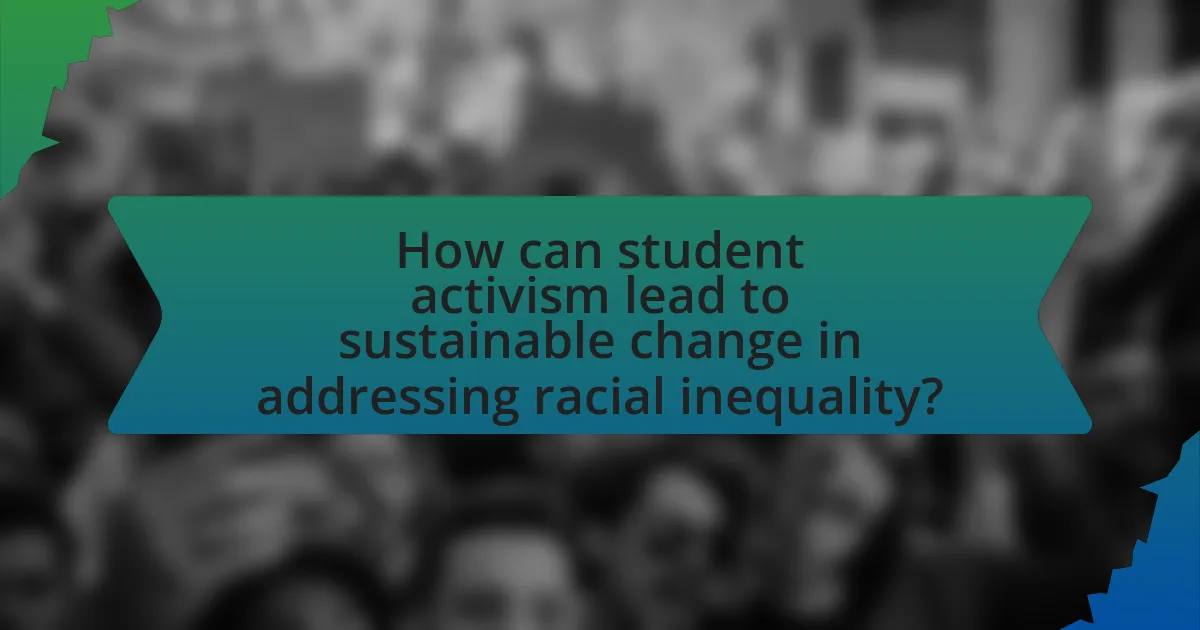
How can student activism lead to sustainable change in addressing racial inequality?
Student activism can lead to sustainable change in addressing racial inequality by mobilizing collective action, raising awareness, and influencing policy reforms. When students organize protests, campaigns, and educational initiatives, they create a platform for dialogue and engagement on racial issues, which can shift public perception and policy priorities. For instance, the Black Lives Matter movement, significantly propelled by student activists, has led to legislative changes in various states aimed at police reform and racial justice. Research indicates that youth-led movements are effective in creating long-term societal impacts, as seen in the 1960s civil rights movement, where student involvement was crucial in achieving landmark legislation like the Civil Rights Act of 1964. Thus, through sustained efforts and strategic advocacy, student activism can effectively challenge systemic racism and promote equitable policies.
What are the long-term effects of student-led initiatives on racial equality?
Student-led initiatives have significant long-term effects on racial equality by fostering awareness, promoting policy changes, and creating a culture of activism. These initiatives often lead to increased engagement in social justice issues among peers and the broader community, as evidenced by movements such as Black Lives Matter, which originated from student activism and has influenced national conversations on race and policy reform. Research indicates that sustained student activism can result in institutional changes, such as the implementation of diversity training programs and the establishment of inclusive curricula in educational institutions. For example, a study by the American Educational Research Association found that student-led campaigns can lead to measurable improvements in school climate and student perceptions of equity.
How can collaboration with community organizations enhance student activism?
Collaboration with community organizations enhances student activism by providing resources, expertise, and a broader platform for advocacy. When students partner with established organizations, they gain access to training, mentorship, and networks that amplify their voices and initiatives. For instance, research by the National Youth Leadership Council indicates that youth engaged in community service projects are more likely to develop leadership skills and civic engagement, which are crucial for effective activism. Additionally, community organizations often have experience in navigating local policies and can guide students in creating impactful campaigns that address racial inequality. This synergy not only strengthens the students’ efforts but also fosters a more inclusive approach to activism, ensuring that diverse perspectives are represented in the fight against racial injustice.
What role does education play in sustaining the momentum of student activism?
Education plays a crucial role in sustaining the momentum of student activism by equipping students with critical thinking skills and awareness of social issues. Through curricula that emphasize social justice, history, and civic engagement, educational institutions foster an environment where students can analyze and challenge systemic inequalities. For instance, studies show that students exposed to discussions on racial inequality are more likely to engage in activism, as evidenced by the increased participation in movements like Black Lives Matter among college students who have taken courses on race and ethnicity. This educational foundation not only informs students about the issues at hand but also empowers them to mobilize their peers and advocate for change effectively.
What practical steps can students take to engage in activism against racial inequality?
Students can engage in activism against racial inequality by organizing awareness campaigns and participating in community outreach programs. These initiatives can include hosting workshops, discussions, and events that educate peers about racial issues and promote inclusivity. For example, the NAACP Youth and College Division has successfully mobilized students to advocate for civil rights through local chapters, demonstrating the effectiveness of student-led activism. Additionally, students can collaborate with local organizations focused on racial justice, volunteer for initiatives that support marginalized communities, and utilize social media platforms to amplify their messages and reach a broader audience. Research indicates that youth activism can significantly influence public opinion and policy changes, as seen in movements like Black Lives Matter, which gained momentum through student involvement and grassroots organizing.
How can students effectively organize events and campaigns for racial justice?
Students can effectively organize events and campaigns for racial justice by forming a dedicated planning committee, establishing clear goals, and engaging the community. A planning committee allows for diverse perspectives and skills, which enhances creativity and outreach. Setting specific, measurable objectives ensures that the campaign remains focused and impactful. Engaging the community through surveys or discussions can identify pressing issues and foster support, as evidenced by the success of campaigns like the Black Lives Matter movement, which mobilized widespread community involvement and awareness. Additionally, utilizing social media platforms for promotion and collaboration can amplify the message and reach a broader audience, as demonstrated by the viral nature of many social justice campaigns.
What resources are available for students interested in activism?
Students interested in activism can access various resources, including organizations, online platforms, and educational materials. Notable organizations such as the American Civil Liberties Union (ACLU) and the NAACP provide tools, guides, and support for activism focused on racial inequality. Online platforms like Change.org and social media channels facilitate petitioning and awareness campaigns. Additionally, educational resources from universities and community colleges often include workshops, seminars, and courses on social justice and activism, equipping students with the knowledge and skills needed to engage effectively in advocacy efforts.
